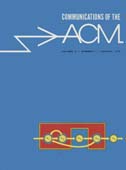January 1970 - Vol. 13 No. 1

Features
Automatic segmentation of cyclic program structures based on connectivity and processor timing
Time-shared, multiprogrammed, and overlayed batch systems frequently require segmentation of computer programs into discrete portions. These program portions are transferred between executable and peripheral storage whenever necessary; segmentation of programs in a manner that reduces the frequency of such transfers is the subject of this paper. Segmentation techniques proposed by C. V. Ramamoorthy are subject to limitations that arise when the preferred segment size is not compatible with the physical restrictions imposed by the available computing equipment. A generalization of Ramamoorthy's suggestions is made in order to allow their application when circumstances are other than ideal.
Recursive computation of certain derivatives&a study of error propagation
A brief study is made of the propagation of errors in linear first-order difference equations. The recursive computation of successive derivatives of ex/x and (cos x)/x is considered as an llustration.
A processor allocation method for time-sharing
A scheduling algorithm is proposed which is intended to minimize changes of tasks on processors and thereby reduce overhead. The algorithm also has application to more general resource allocation problems. It is implemented by means of a method for efficiently handling dynamically changing segmented lists.
Natural language question-answering systems: 1969
Recent experiments in programming natural language question-answering systems are reviewed to summarize the methods that have been developed for syntactic, semantic, and logical analysis of English strings. It is concluded that at least minimally effective techniques have been devised for answering questions from natural language subsets in small scale experimental systems and that a useful paradigm has evolved to guide research efforts in the field. Current approaches to semantic analysis and logical inference are seen to be effective beginnings but of questionable generality with respect either to subtle aspects of meaning or to applications over large subsets of English. Generalizing from current small-scale experiments to language-processing systems based on dictionaries with thousands of entries—with correspondingly large grammars and semantic systems—may entail a new order of complexity and require the invention and development of entirely different approaches to semantic analysis and question answering.
Experience with an extensible language
An operational extensible language system is described. The system and its base language are appraised with respect to efficiency, flexibility, and utility for different categories of users.
A note on minimal length polygonal approximation to a digitized contour
A method for extracting a smooth polygonal contour from a digitized image is illustrated. The ordered sequence of contour points and the connection graph of the image are first obtained by a modified Ledley algorithm in one image scan. A minimal perimeter polygon subjected to specified constraints is then chosen as the approximating contour. The determination of the minimal polygon can be reduced to a nonlinear programming problem, solved by an algorithm which takes into account the weak bonds between variables. Some examples are presented, and the corresponding computing times are listed.
Interchange rolls of perforated tape for information interchange
This proposed American National Standard has been accepted for publication by American National Standards (formerly USASI) Committee X3, Computers and Information Processing. In order that the final version of the proposed standard reflect the largest public consensus, X3 authorized publication of this document to elicit comment and general public reaction, with the understanding that such a working document is an intermediate result in the standardization process and is subject to change, modification, or withdrawal in part or in whole. Comments should be addressed to the X3 Secretary, Business Equipment Manufacturers Association, 235 East 42 Street, New York, NY 10017.—C.K.
Fortran Tausworthe pseudorandom number generator
Intermediate computations in an “Extremely Portable Random Number Generator” by J. B. Kruskal [Comm. ACM 12, 2 (Feb. 1969), 93-94] exceed 15 bits plus sign. This is a severe limitation since the majority of small computers uses a 16 bit (15 bits plus sign) word or less. ASA standard FORTRAN compilers for these machines are readily available. Fortunately, a linearly recurring sequence generator [2] can be written in somewhat “portable” ASA Standard FORTRAN which will produce maximum length [2** (word size of computer - 1) -1] pseudorandom numbers for common 12, 16, 18, 24, and 32 bit computers, to mention only a few. Following Kendall's algorithm and notation presented by Whittlesey for a p-bit computer: p = 12, N = 11, M = 2; p = 16, N = 15, M = 1, 4, or 7; p = 18, N = 17, M = 3, 5, or 6; p = 24, N = 23, M = 5 or 9; and p = 32, N = 31, M = 3, 6, 7, or 13.



